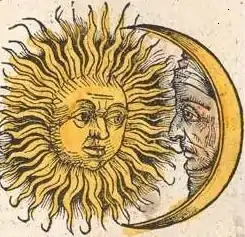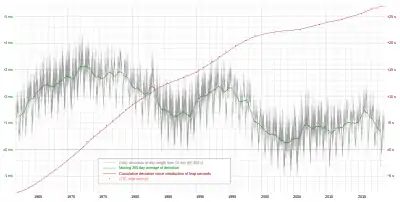Day
A day is approximately the period of time during which the Earth completes one rotation around its axis.[1] A solar day is the length of time which elapses between the Sun reaching its highest point in the sky two consecutive times.[2] Days on other planets are defined similarly and vary in length due to differing rotation periods, that of Mars being slightly longer and sometimes called a sol.
The unit of measurement "day" is defined as 86,400 SI seconds and symbolized d. The second is designated the SI base unit of time. Previously, it was defined in terms of the orbital motion of the Earth in the year 1900, but since 1967 the second and so the day are defined by atomic electron transition.[3] A civil day is usually 24 hours, plus or minus a possible leap second in Coordinated Universal Time (UTC), and occasionally plus or minus an hour in those locations that change from or to daylight saving time.
Day can be defined as each of the twenty-four-hour periods, reckoned from one midnight to the next, into which a week, month, or year is divided, and corresponding to a rotation of the earth on its axis.[4] However, its use depends on its context; for example, when people say 'day and night', 'day' will have a different meaning: the interval of light between two successive nights, the time between sunrise and sunset;[5] the time of light between one night and the next.[6] For clarity when meaning 'day' in that sense, the word "daytime" may be used instead,[7][8] though context and phrasing often makes the meaning clear. The word day may also refer to a day of the week or to a calendar date, as in answer to the question, "On which day?" The life patterns (circadian rhythms) of humans and many other species are related to Earth's solar day and the day-night cycle.

Introduction

Apparent and mean solar day
Several definitions of this universal human concept are used according to context, need and convenience. Besides the day of 24 hours (86,400 seconds), the word day is used for several different spans of time based on the rotation of the Earth around its axis. An important one is the solar day, defined as the time it takes for the Sun to return to its culmination point (its highest point in the sky). Because celestial orbits are not perfectly circular, and thus objects travel at different speeds at various positions in their orbit, a solar day is not the same length of time throughout the orbital year. Because the Earth moves along an eccentric orbit around the Sun while the Earth spins on an inclined axis, this period can be up to 7.9 seconds more than (or less than) 24 hours. In recent decades, the average length of a solar day on Earth has been about 86,400.002 seconds[9] (24.000 000 6 hours) and there are currently about 365.242199 solar days in one mean tropical year.
Ancient custom has a new day start at either the rising or setting of the Sun on the local horizon (Italian reckoning, for example, being 24 hours from sunset, oldstyle).[10] The exact moment of, and the interval between, two sunrises or sunsets depends on the geographical position (longitude as well as latitude), and the time of year (as indicated by ancient hemispherical sundials).
A more constant day can be defined by the Sun passing through the local meridian, which happens at local noon (upper culmination) or midnight (lower culmination). The exact moment is dependent on the geographical longitude, and to a lesser extent on the time of the year. The length of such a day is nearly constant (24 hours ± 30 seconds). This is the time as indicated by modern sundials.
A further improvement defines a fictitious mean Sun that moves with constant speed along the celestial equator; the speed is the same as the average speed of the real Sun, but this removes the variation over a year as the Earth moves along its orbit around the Sun (due to both its velocity and its axial tilt).
Stellar day
A day, understood as the span of time it takes for the Earth to make one entire rotation[11] with respect to the celestial background or a distant star (assumed to be fixed), is called a stellar day. This period of rotation is about 4 minutes less than 24 hours (23 hours 56 minutes and 4.09 seconds) and there are about 366.2422 stellar days in one mean tropical year (one stellar day more than the number of solar days). Other planets and moons have stellar and solar days of different lengths from Earth's.
Besides a stellar day on Earth, there are related such days for bodies in the Solar System other than the Earth.[12]
- Ceres: 9 hours, 4 minutes
- Jupiter: 9 hours, 56 minutes
- Saturn: 10 hours, 33 minutes
- Neptune: 16 hours, 6 minutes
- Uranus: 17 hours, 14 minutes
- Earth: 23 hours, 56 minutes
- Mars: 1 day, 37 minutes
- Pluto: 6 days, 9 hours
- Earth's Moon: 27 days, 7 hours, 12 minutes
- Mercury: 58 days, 15 hours, 30 minutes
- Venus: 243 days
Daytime
A day, in the sense of daytime that is distinguished from night time, is commonly defined as the period during which sunlight directly reaches the ground, assuming that there are no local obstacles. The length of daytime averages slightly more than half of the 24-hour day. Two effects make daytime on average longer than nights. The Sun is not a point, but has an apparent size of about 32 minutes of arc. Additionally, the atmosphere refracts sunlight in such a way that some of it reaches the ground even when the Sun is below the horizon by about 34 minutes of arc. So the first light reaches the ground when the centre of the Sun is still below the horizon by about 50 minutes of arc.[13] Thus, daytime is on average around 7 minutes longer than 12 hours.[14]
Etymology
The term comes from the Old English dæg, with its cognates such as dagur in Icelandic, Tag in German, and dag in Norwegian, Danish, Swedish and Dutch. All of them from the Indo-European root dyau which explains the similarity with Latin dies though the word is known to come from the Germanic branch. As of October 17, 2015, day is the 205th most common word in US English,[15] and the 210th most common in UK English.[15]
International System of Units (SI)
A day, symbol d, defined as 86,400 seconds, is not an SI unit, but is accepted for use with SI.[16] The second is the base unit of time in SI units.
In 1967–68, during the 13th CGPM (Resolution 1),[17] the International Bureau of Weights and Measures (BIPM) redefined a second as
... the duration of 9 192 631 770 periods of the radiation corresponding to the transition between two hyperfine levels of the ground state of the caesium 133 atom.[18]
This makes the SI-based day last exactly 794, 243, 384, 928, 000 of those periods.
Leap seconds
Mainly due to tidal effects, the Earth's rotational period is not constant, resulting in minor variations for both solar days and stellar "days". The Earth's day has increased in length over time due to tides raised by the Moon which slow Earth's rotation. Because of the way the second is defined, the mean length of a day is now about 86, 400.002 seconds, and is increasing by about 1.7 milliseconds per century (an average over the last 2, 700 years). The length of a day circa 620 million years ago has been estimated from rhythmites (alternating layers in sandstone) as having been about 21.9 hours.
In order to keep the civil day aligned with the apparent movement of the Sun, a day according to Coordinated Universal Time (UTC) can include a negative or positive leap second. Therefore, although typically 86,400 SI seconds in duration, a civil day can be either 86,401 or 86,399 SI seconds long on such a day.
Leap seconds are announced in advance by the International Earth Rotation and Reference Systems Service (IERS), which measures the Earth's rotation and determines whether a leap second is necessary.
Civil day
For civil purposes, a common clock time is typically defined for an entire region based on the local mean solar time at a central meridian. Such time zones began to be adopted about the middle of the 19th century when railroads with regularly occurring schedules came into use, with most major countries having adopted them by 1929. As of 2015, throughout the world, 40 such zones are now in use: the central zone, from which all others are defined as offsets, is known as UTC±00, which uses Coordinated Universal Time (UTC).
The most common convention starts the civil day at midnight: this is near the time of the lower culmination of the Sun on the central meridian of the time zone. Such a day may be referred to as a calendar day.
A day is commonly divided into 24 hours of 60 minutes, with each minute composed of 60 seconds.
Decimal and metric time
In the 19th century, an idea circulated to make a decimal fraction (1⁄10, 000 or 1⁄100, 000) of an astronomical day the base unit of time. This was an afterglow of the short-lived movement toward a decimalisation of timekeeping and the calendar, which had been given up already due to its difficulty in transitioning from traditional, more familiar units. The most successful alternative is the centiday, equal to 14.4 minutes (864 seconds), being not only a shorter multiple of an hour (0.24 vs 2.4) but also closer to the SI multiple kilosecond (1, 000 seconds) and equal to the traditional Chinese unit, kè.
Colloquial
The word refers to various similarly defined ideas, such as:
- Full day
- 24 hours (exactly) (a nychthemeron)
- A day counting approximation, for example "See you in three days." or "the following day"
- The full day covering both the dark and light periods, beginning from the start of the dark period or from a point near the middle of the dark period
- A full dark and light period, sometimes called a nychthemeron in English, from the Greek for night-day;[19] or more colloquially the term 24 hours. In other languages, 24 hours is also often used. Other languages also have a separate word for a full day.
- Part of a date: the day of the year (doy) in ordinal dates, day of the month (dom) in calendar dates or day of the week (dow) in week dates.
- Time regularly spend at paid work on a single work day, cf. man-day and workweek.
- Daytime
- The period of light when the Sun is above the local horizon (that is, the time period from sunrise to sunset)
- The time period from 06:00–18:00 (6:00 am – 6:00 pm) or 21:00 (9:00 pm) or another fixed clock period overlapping or offset from other time periods such as "morning", "evening", or "night".
- The time period from first-light "dawn" to last-light "dusk".
- Other
- A specific period of the day, which may vary by context, such as "the school day" or "the work day".
Boundaries

For most diurnal animals, the day naturally begins at dawn and ends at sunset. Humans, with their cultural norms and scientific knowledge, have employed several different conceptions of the day's boundaries. In the Hebrew Bible, Genesis 1:5 defines a day in terms of "evening" and "morning" before recounting the creation of a sun to illuminate it: "And God called the light Day, and the darkness he called Night. And the evening and the morning were the first day." Common convention among the ancient Romans,[20] ancient Chinese[21] and in modern times is for the civil day to begin at midnight, i.e. 00:00, and to last a full 24 hours until 24:00 (i.e. 00:00 of the next day). In ancient Egypt the day was reckoned from sunrise to sunrise. The Jewish day begins at either sunset or nightfall (when three second-magnitude stars appear).
Medieval Europe also followed this tradition, known as Florentine reckoning: in this system, a reference like "two hours into the day" meant two hours after sunset and thus times during the evening need to be shifted back one calendar day in modern reckoning. Days such as Christmas Eve, Halloween, and the Eve of Saint Agnes are remnants of the older pattern when holidays began during the prior evening. Prior to 1926, Turkey had two time systems: Turkish (counting the hours from sunset) and French (counting the hours from midnight).
Validity of tickets, passes, etc., for a day or a number of days may end at midnight, or closing time, whichever occurs earlier. However, if a service (e.g., public transport) operates from for example, 6:00 to 1:00 the next day (which may be noted as 25:00), the last hour may well count as being part of the previous day. For services depending on the day ("closed on Sundays", "does not run on Fridays", and so on) there is a risk of ambiguity. For example, a day ticket on the Nederlandse Spoorwegen (Dutch Railways) is valid for 28 hours, from 0:00 to 28:00 (that is, 4:00 the next day); the validity of a pass on Transport for London (TfL) services runs until the end of the "transport day" – that is to say, until 4:30 am on the day after the "expires" date stamped on the pass.
Midnight sun
In places which experience the midnight sun (polar day), daytime may extend beyond one 24-hour period and could even extend to months.
See also
- 24-hour clock
- Daylight
- Day length fluctuations
- Determination of the day of the week
- Holiday
- ISO 8601
- Season, for a discussion of daylight and darkness at various latitudes
- Synodic day
- Sidereal time
- World Meteorological day
- Zmanim
References
- Weisstein, Eric W. (2007). "Day". Retrieved 2011-05-31.
- Weisstein, Eric W. (2007). "Solar Day". Retrieved 2011-05-31.
- BIPM (2014) [2006]. "Unit of time (second)". SI Brochure (8th ed.).
- "day – Definition of day in English by Oxford Dictionaries". Oxford Dictionaries – English.
- "day" – via The Free Dictionary.
- "Definition of DAY". www.merriam-webster.com.
- Online Dictionary Definitions of "day".
- Online Dictionary Definitions of "daytime"
- The average over the last 50 years is about 86,400.002. The yearly average over that period has ranged between about 86,400 and 86,400.003, while the length of individual days has varied between about 86,399.999 and 86,400.004 seconds. See this graph: (data from "Earth Orientation Parameters". International Earth Rotation and Reference Systems Service. Archived from the original on April 26, 2015.).

- L. Holford-Stevens, The History of Time (Oxford 2005) p. 6
-
Certain authors caution against identifying "day" with rotation period. For example: Courtney Seligman. "Rotation Period and Day Length". Retrieved 2011-06-03.
A Cautionary Note: Because the rotation period of the Earth is almost the same as the length of its day, we sometimes get a bit sloppy in discussing the rotation of the sky, and say that the stars rotate around us once each day. In a similar way, it is not unusual for careless people to mix up the rotation period of a planet with the length of its day, or vice versa.
- Griggs, Mary Beth (18 January 2019). "Shaky rings help scientists measure Saturn's days – Speedy planet". The Verge. Retrieved 18 January 2019.
- 32′⁄2 + 34′ = 50′
- 50°/60 ÷ 360° × 2(for sunrise and set) × 24 hours ≈ 7 min
- "English Words". Oxford Dictionaries Online (ODO). Oxford University Press. Retrieved 2015-10-17.
- BIPM (2014) [2006]. "Non-SI units accepted for use with the SI, and units based on fundamental constants". SI Brochure (8th ed.).
- "SI Unit of Time (Second)". Resolution 1 of the 13th CGPM (1967/68). Bureau International des Poids et Mesures (BIPM). Archived from the original on 2011-01-10. Retrieved 2015-10-17.
- "Unit of Time (Second)". SI Brochure: The International System of Units (SI) (8 ed.). Bureau International des Poids et Mesures (BIPM). 2014 [2006]. Retrieved 2015-10-17.
- "Definition of NYCHTHEMERON". www.merriam-webster.com. Retrieved 2017-02-01.
- See Plutarch, Quaestiones Romanae, 84.
- s:zh:清史稿/卷48: 起子正,盡夜子初。




